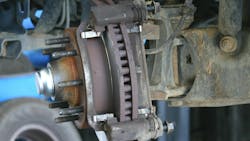Brake Safety Week '25 prep tips from Bendix
Key Highlights
- CVSA's Brake Safety Week is from Aug. 24-30 this year
- Technicians and drivers should know what to look for during regular, pre-, and post-trip inspections to make sure their brakes are in working order
- Additionally, fleets should keep in mind the maintenance and wear differences between disc and drum brakes, as well as how to know when it's time to replace brake components
Two things are certain as summer comes to a close: kids go back to school, and fleets with bad brakes get sent to detention. Yes, it's nearly Brake Safety Week, this year held Aug. 24-30, the Commercial Vehicle Safety Alliance's annual pop quiz to check if CVs' braking systems make the grade. A failing grade on this test usually means a truck is placed out of service, so there's not much time to cram in last-minute maintenance.
Differences between drums and discs
Air disc brakes and drum brakes have a few differing maintenance needs where Brake Safety Week is concerned – key among them the measurement of brake stroke. Because air disc brakes include an internal adjustment mechanism, their brake stroke is not measured externally, as is the case with drum brakes. The internal adjustment mechanism significantly lowers the risk of out-of-adjustment violations.
“Measuring a drum brake’s chamber stroke is a matter of checking the distance from the face of the air brake chamber to the clevis pin with the brakes released, and then again after a fully charged brake application,” Screeton explained. “The difference between these measurements is the brake stroke, and its maximum length depends upon the brake chamber type and size.”
Improperly adjusted brakes can also drag — impacting fuel efficiency and speeding up pad wear — or experience decreased stopping power.
Parts selection for brake system health
“If you notice it’s time for new brake friction, then make sure to keep things up to spec: Not all friction that is marketed as ‘acceptable’ under current reduced stopping distance (RSD) regulations will actually perform to that standard,” Screeton said. “Whether you’re replacing air disc brake pads or drum brake shoes, select components that will ensure the original equipment manufacturer (OEM) requirements are met so that the vehicle remains compliant.”
The aftermarket is more crowded than ever, particularly when it comes to brake friction. The wrong choice can harm your system and undermine vehicle safety. Complications arising from improper friction selection can include cracks, degradation of braking performance, or damage to other wheel-end components. Remember, these are things that a roadside inspector can note and penalize you for.
Keep in mind product advancements that can help prevent wheel-end issues typical during Brake Safety Week, including sealed spring brake chambers and air disc brake pad wear sensing technology. Sealed chambers, like the Bendix EnduraSure-Pro, are designed to address the main vulnerability of traditional models — exposure to contaminants, which can corrode the power spring and lead to its failure.
Air disc brake wear sensing technology, such as Bendix iSense Pro, alerts fleets, via telematics, when ADB pads and rotors are nearing end of life. It also helps fleets avoid the risk of damaging costly rotors—rotors being a focal point of this year’s inspections—through early detection while assisting with the development of optimal friction replacement schedules.
“Be aware of the friction couple, as well—that is, the pairing of brake pads and rotors in air disc brakes,” Screeton said. “When those parts are designed in isolation, and then paired together, problems can follow—including stress cracks from heat and grooves from uneven wear. Choose ADBs, such as the Bendix ADB22X, in which the components are engineered to work together, which can help prevent issues before they start.”
You’ll also want to protect the air supply against corrosive oil aerosols that lead to leaks and potential violations. Bendix recommends using an oil-coalescing air dryer cartridge like the Bendix PuraGuard. Oil-coalescing cartridges can be used to replace standard cartridges, but the reverse is not the case: You shouldn’t downgrade from an oil-coalescing cartridge to a standard. Also, not all oil-coalescing cartridges work the same. Bendix recommends you replace a cartridge with the same one that was removed from the OEM vehicle.
Tech Support
“Any indication of something out of compliance can be a sign of potentially wider maintenance issues,” Screeton said. “Taken individually, everything inspectors are looking for—such as a kink in an air hose or an active full-stability light on the dash—may seem inconsequential. But it’s critical to take this holistic approach to upkeep when considering the complex interconnectivity of the entire brake system and more advanced safety technologies. One small sign of something out of compliance can be an indicator of more widespread maintenance issues.”
Screeton emphasizes the importance of communication between drivers and technicians.
“A driver out on the road may be the first one to notice an issue with the truck,” he said. “It’s vital that the driver be able to tell the technician what happened, where it happened, and details such as weather conditions. And it’s just as vital for the technician to ask questions to gain a clearer understanding of the situation.”
